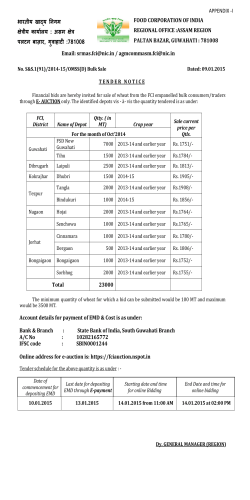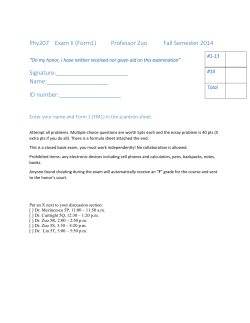
(A) Find the current in the circuit.
3-12-2014 FCI 1 Direct Current Circuits: 3-1 EMF 3-2 Resistance in series and parallel . 3-3 Rc circuit 3-4 Electrical instruments 3-12-2014 FCI 2 Example: (A) Find the current in the circuit. starting at a, we see that a b represents a potential difference of + Ɛ1 b c represents a potential difference of -IR1, c d represents a potential difference of - Ɛ2, and d a represents a potential difference of -IR2 3-12-2014 FCI 3 The negative sign for I indicates that the direction of the current is opposite the assumed direction. (B) What power is delivered to each resistor? What power is delivered by the 12-V battery? 3-12-2014 FCI 4 Problem-Solving Strategy – Kirchhoff’s Rules Draw the circuit diagram and assign labels and symbols to all known and unknown quantities Assign directions to the currents. Apply the junction rule to any junction in the circuit Apply the loop rule to as many loops as are needed to solve for the unknowns Solve the equations simultaneously for the unknown quantities Check your answers 3-12-2014 FCI 5 Example: A) Under steady-state conditions, find the unknown currents I1, I2, and I3 in the multiloop circuit shown in Figurev 3-12-2014 FCI 6 (B) What is the charge on the capacitor? We can apply Kirchhoff’s loop rule to loop bghab (or any other loop that contains the capacitor) to find the potential difference ∆Vcap across the capacitor. We use this potential difference in the loop equation without reference to a sign convention because the charge on the capacitor depends only on the magnitude of the potential difference. Moving clockwise around this loop, we obtain 3-12-2014 FCI 7 Quiz 3: In using Kirchhoff’s rules, you generally assign a separate unknown current to (a) each resistor in the circuit (b) each loop in the circuit (c) each branch in the circuit (d) each battery in the circuit. 3-12-2014 FCI 8 Ans. (c) each branch in the circuit A current is assigned to a given branch of a circuit. There may be multiple resistors and batteries in a given branch. 3-12-2014 FCI 9 RC Circuits A direct current circuit may contain capacitors and resistors, the current will vary with time When the circuit is completed, the capacitor starts to charge The capacitor continues to charge until it reaches its maximum charge (Q = Cε) Once the capacitor is fully charged, the current in the circuit is zero 3-12-2014 FCI 10 Charging Capacitor in an RC Circuit The charge on the capacitor varies with time q = Q(1 – e-t/RC) The time constant, =RC The time constant represents the time required for the charge to increase from zero to 63.2% of its maximum 3-12-2014 FCI 11 The following dimensional analysis shows that τ has the units of time: The energy output of the battery as the capacitor is fully charged is Q Ɛ= Ɛ C 2. After the capacitor is fully charged, the energy stored in the capacitor is 1/2Q Ɛ = 1/2 CƐ 2, which is just half the energy output of the battery. 3-12-2014 FCI 12 Notes on Time Constant In a circuit with a large time constant, the capacitor charges very slowly The capacitor charges very quickly if there is a small time constant 3-12-2014 FCI 13 Discharging Capacitor in an RC Circuit When a charged capacitor is placed in the circuit, it can be discharged q = Q e-t/RC The charge decreases exponentially At t = = RC, the charge decreases to 0.368 Qmax In other words, in one time constant, the capacitor loses 63.2% of its initial charge 3-12-2014 FCI 14 5- Electric meter Ammeters and Voltmeters An ammeter is a device for measuring current, and a voltmeter measures voltages. The current in the circuit must flow through the ammeter; therefore the ammeter should have as low a resistance as possible, for the least disturbance. 3-12-2014 FCI 15 Ammeters and Voltmeters A voltmeter measures the potential drop between two points in a circuit. It therefore is connected in parallel; in order to minimize the effect on the circuit, it should have as large a resistance as possible. 3-12-2014 FCI 16 Summary • Power in an electric circuit: • If the material obeys Ohm’s law, • Energy equivalent of one kilowatt-hour: • Equivalent resistance for resistors in series: 3-12-2014 FCI 17 Summary • Inverse of the equivalent resistance of resistors in series: • Junction rule: All current that enters a junction must also leave it. • Loop rule: The algebraic sum of all potential charges around a closed loop must be zero. 3-12-2014 FCI 18 Summary • Equivalent capacitance of capacitors connected in parallel: • Inverse of the equivalent capacitance of capacitors connected in series: 3-12-2014 FCI 19 Kirchhoff’s rules: 1- Junction rule. The sum of the currents entering any junction in an electric circuit must equal the sum of the currents leaving that junction: 2- Loop rule. The sum of the potential differences across all elements around any circuit loop must be zero: The first rule is a statement of conservation of charge; the second is equivalent to a statement of conservation of energy. 3-12-2014 FCI 20 Note: When a resistor is traversed in the direction of the current, the potential difference ∆V across the resistor is -IR. When a resistor is traversed in the direction opposite the current, ∆V = +IR. When a source of emf is traversed in the direction of the emf (negative terminal to positive terminal), the potential difference is +Ɛ . When a source of emf is traversed opposite the emf (positive to negative), the potential difference is -Ɛ 3-12-2014 FCI 21 • Charging a capacitor: where Q = C Ɛ is the maximum charge on the capacitor. The product RC is called the time constant Ƭ of the circuit. • Discharging a capacitor: where Q is the initial charge on the capacitor and I0 = Q /RC is the initial current in the circuit. 3-12-2014 FCI 22 Summary • Ammeter: measures current. Is connected in series. Resistance should be as small as possible. • Voltmeter: measures voltage. Is connected in parallel. Resistance should be as large as possible. 3-12-2014 FCI 23 Household Circuits The utility company distributes electric power to individual houses with a pair of wires Electrical devices in the house are connected in parallel with those wires The potential difference between the wires is about 120V 3-12-2014 FCI 24 3-12-2014 FCI 25
© Copyright 2025











